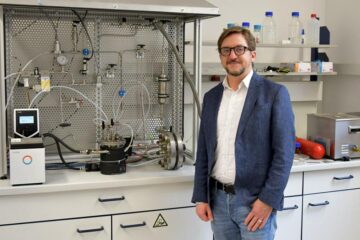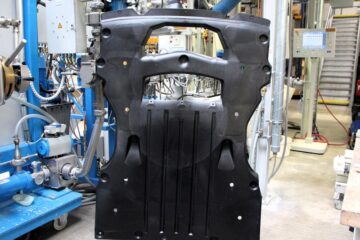Cervical Tissue Changes May Explain False Negative Pap Smears

Study findings suggest the routine tests for cervical cancer sometimes cannot pick up abnormal cells because cells are tightly adhered to cervix
Some women may be getting false negative results on their routine Pap tests early picked up during the exam, according to a study released today.
Writing in the June issue of the American Journal of Obstetrics & Gynecology, physicians at the Keck School of Medicine of USC and colleagues in California and Taiwan are the first to suggest this explanation for the frequent occurrence of false negative Pap smears.
Nationwide, physicians perform about 55 million Pap tests every year to look for cervical cells that are becoming abnormal, a precursor to cancer. To perform such a smear, a physician inserts a swab through a patient¹s vagina and scrapes the cervix to collect a sample of cells shed from its surface. Pathologists analyze the cells under a microscope to see if they are healthy.
Unfortunately, as many as four in 10 test results come back negative even when a biopsy shows abnormal lesions, and researchers have not been able to conclusively explain the inconsistencies.
A substance called E-cadherin may lie at the heart of the problem, says the study¹s lead author, Juan C. Felix, M.D., professor of clinical pathology and obstetrics and gynecology at the Keck School of Medicine of USC.
E-cadherin is a molecule that helps cells in the cervical tissue stick together, Felix explains. Normally, E-cadherin can be found in cervical tissue, except on the cervix¹s surface (the superficial epithelial layers). With no E-cadherin there, older cells can detach and slough away from the surface of the cervix, much like dead cells are regularly exfoliated from the surface of the skin.
However, the researchers found that in some cervical lesions, E-cadherin also was abnormally present in cells on the cervix¹s surface, keeping the abnormal epithelial cells anchored to the cells beneath them. Researchers theorize that this bond keeps these telltale aberrant cells from being collected during testing.
„I am convinced that the findings of this study are extremely important in understanding the biology of the false negative Pap smear,“ Felix says. „Never before have we seen such clear evidence that barriers to exfoliation are linked to false negative Pap smears.“
The team conducted the study with tissue samples from 25 women known to have cervical dysplasia (aberrant cells preceding cancer). Researchers analyzed whether the tissue samples showed normal distribution of E-cadherin, and then compared each tissue sample to its corresponding Pap smear result.
Of the 25 women, 12 had had a normal Pap smear. All 12 of these women, however, had a positive result through speculoscopy with PapSure. PapSure is a testing system that includes a special light used during the pelvic examination, allowing physicians to actually see suspicious lesions on the cervix.
The remaining 13 women had abnormal Pap smears. Researchers were able to analyze E-cadherin distribution in 10 of these samples. Eight of 10 of these samples showed normal distribution of E-cadherin.
In contrast, of the 12 women with false negative Pap smears, 10 of 11 samples that could be examined showed the abnormal presence of E-cadherin in the superficial layers of the cervix.
„Of the patients with known cervical abnormalities who had normal Pap smears, 91 percent had an abnormal distribution of the E-cadherin adhesion molecule,“ Felix says. Felix cautions, however, that larger studies with randomly selected patients are needed to verify the findings. Other adhesion molecules also may be involved in the process.
Possible alternative reasons for false-negative Pap smears include poor cell sample collection, mistakes in transferring cells to slides and human error in evaluating the collected cells.
The American Cancer Society estimates that 13,000 women in the United States will be diagnosed with cervical cancer this year and 4,100 women will die of the disease.
The study was supported in part by Torrance-based Trylon Corp., which developed the PapSure system. Watson Pharmaceuticals Inc., of Corona, Calif., now owns rights to PapSure.
Juan C. Felix, Neal M. Lonky, Kimi Tamura, Ken-Jen Yu, Yathi Naidu, Chung-Rui Lai and Stewart A. Lonky. „Aberrant expression of E-cadherin in cervical intraepithelial neoplasia correlates with a false negative Papanicolaou smear.“ American Journal of Obstetrics & Gynecology, Vol. 186, No. 6, June 2002.
Media Contact
Weitere Informationen:
http://uscnews3.usc.edu/experts/index.htmlAlle Nachrichten aus der Kategorie: Medizin Gesundheit
Dieser Fachbereich fasst die Vielzahl der medizinischen Fachrichtungen aus dem Bereich der Humanmedizin zusammen.
Unter anderem finden Sie hier Berichte aus den Teilbereichen: Anästhesiologie, Anatomie, Chirurgie, Humangenetik, Hygiene und Umweltmedizin, Innere Medizin, Neurologie, Pharmakologie, Physiologie, Urologie oder Zahnmedizin.
Neueste Beiträge

Wasserstoff-Produktion in der heimischen Garage
Forschungsteam der Frankfurt UAS entwickelt Prototyp für Privathaushalte: Förderzusage vom Land Hessen für 2. Projektphase. Wasserstoff als Energieträger der Zukunft ist nicht frei verfügbar, sondern muss aufwendig hergestellt werden. Das…

Fahrzeugunterböden aus Naturfasern und Recycling-Kunststoffen
Gemeinsam mit Industriepartnern haben Forschende des Fraunhofer WKI einen Fahrzeugunterboden aus Naturfasern sowie recycelten Kunststoffen für den Automobilbau entwickelt. Das Bauteil erfüllt die hohen technischen Anforderungen im Unterbodenbereich und könnte…

Pfunde schmelzen mittels Piks
Was ist dran an der Abnehmspritze? Endlich schlank und das ohne große Mühen. Die Abnehmspritze, auch bekannt als Fett-weg-Spritze, hat sich von einem Medikament für Diabetiker:innen zu einer Art Lifestyleprodukt…





















